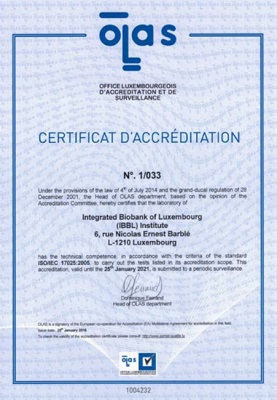
A 2015 audit has led the Integrated Biobank of Luxembourg (IBBL) to become one of the few biobanks wolrdwide to obtain ISO 17025 accreditation.
This accreditation, which specifies the general requirements for the competence of testing and calibration laboratories, was issued by the Office Luxembourgeois d'Accreditation et de Surveillance (OLAS). It covers an initial period of 5 years and the following testing methods: Complete Blood Count with ABX Micros CRP 200; DNA Quantification by Spectrofluorometry; Nucleic Acid Quantification by Spectrophotometry; and RNA Integrity Measurement.
The biobank has additionally announced plans to expand the scope of its accreditation through the incorporation of further biospecimen testing methods, which will be assessed during yearly follow-up audits. IBBL has created a significant portfolio of sample processing and analysis methods to complement traditional logistics and storage services offered by biobanks, and announced yesterday the launch of a six service package.
The accreditation has validated IBBL's competence in providing high-quality, well-annotated samples, data and services, and represents an achievement for the biobank's staff.
"Being one of only a handful ofbiobanks in the world that is accredited according to ISO17025 is a great reward for the team that has worked tirelessly over the last few years," remarked Marc Vandelaer, Chief Executive Officer of IBBL. "2015 has been an outstanding year for us in terms of quality. Not only did we pass our first accreditation audit, we also successfully passed the follow-up audits for our ISO 9001 and NF S96-900 certifications. Last but not least, we won the Luxembourg Quality and Excellence Award in the category for small companies."
The quality management system was set up by Dr. Sabine Lehmann who has supervised the process which ensures that researchers receive samples fit for purpose and of uniform quality and therefore are able to work more efficiently whilst saving time and money. In addition, this enables donors to know that their contribution to research is being carefully used.
Photo by IBBL








